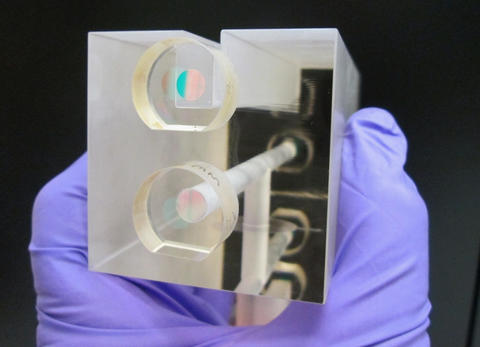FLOC Pressure Sensor

The Technology
NIST scientists have devised and validated a revolutionary pressure technology in an instrument called the Fixed Length Optical Cavity (FLOC). Its operation is based on the fact that, at a given temperature, the pressure of a gas is determined when the inherent gas refractive index is also known. The design, which can provide as much as 35 times higher precision than the NIST national standard mercury manometer, has been miniaturized from initial prototype lengths of around 30 centimeters to 2.5 cm in partnership with industry.
The FLOC works by comparing the speed at which light moves through a gas with its speed in vacuum. As the pressure increases, the slower the light moves through the pressurized gas. The ratio of these two speeds defines the optical refractive index, which changes proportionally with pressure. The NIST instrument sends identical laser beams down two cylindrical cavities of identical length: One is held in vacuum; the other contains the gas pressure to be measured. Each cavity has mirrors at both ends, causing the light to form standing waves of different wavelengths. Comparing wavelengths of the light from each cavity provides a sensitive measure of pressure. Because different gases have different refractive indexes at identical pressures, the inherent gas refractive index must also be known from quantum-chemistry calculations or another high-accuracy experimental method.
In collaboration with industry, a transportable version of the FLOC has been developed. This device will enable pressure measurements to have primary traceability to the SI through the inherent refractive index of the gas. Because the device is quantum-based, it does not require recalibration at NIST.
NIST researchers are also developing a high-accuracy experimental method for measuring the inherent refractive indexes of any gas with a Variable-Length Optical Cavity (VLOC). It contains three vacuum cavities and one gas cavity, each with rigid mirrors at either end. Measurements can be taken at two different cavity lengths. Because any systematic errors, such as bending, distortions or gas absorption, will be the same at both lengths, subtracting the two readings will reveal the gas’s refractive index with extraordinary accuracy.
Advantages Over Existing Methods
High-end mercury manometers are still in widespread use in industry and science. (NIST’s national standard manometer contains a three-meter column of mercury.) But that technology has reached the point at which its accuracy cannot be further improved. And mercury is a dangerous neurotoxin that is being phased out worldwide. The FLOC eliminates that problem entirely.
Moreover, its small size makes it deployable in a range of industrial settings and conditions for which mercury manometers are ill-suited.
Applications
Precision pressure measurements are essential to dozens of large-scale industrial applications such as petroleum refining, as well as in aircraft altimeters, internal combustion engines and turbines, flow measurement, leak detection, microchip manufacture and aerospace.
NIST’s photonic manometer designs could be used both to make direct pressure measurements and to calibrate instruments that track liquid flow, differential pressure, specific gravity and other properties.
Key Papers
J. Hendricks. Quantum for pressure. Nature Physics. Jan. 5, 2018. DOI: 10.1038/nphys4338
J. Scherschligta, J.A. Fedchak, Z. Ahmed, D.S. Barker, K. Douglass, S. Eckel, E. Hanson, J. Hendricks, N. Klimov, T. Purdy, J. Ricker, R. Singh and J. Stone. Review Article: Quantum-based vacuum metrology at the National Institute of Standards and Technology. Journal of Vacuum Science & Technology A. June 20, 2018. DOI: 10.1116/1.5033568
P.F. Egana, J.A. Stone, J.E. Ricker and J.H. Hendricks. Comparison measurements of low-pressure between a laser refractometer and ultrasonic manometer. Review of Scientific Instruments. May 13, 2016. DOI: 10.1063/1.4949504
M. Puchalski, K. Piszczatowski, J. Komasa, B. Jeziorski and K. Szalewicz. Theoretical determination of the polarizability dispersion and the refractive index of helium. Physical Review A. March 23, 2016. DOI: 10.1103/PhysRevA.93.032515
J. Stone, P. Egan, D. Gerty, J. Hendricks, D. Olson, J. Ricker, G. Scace and G. Strouse. Picometer Metrology for Precise Measurement of Refractive Index, Pressure, and Temperature. Journal of Measurement Science. May 12, 2016. DOI: 10.1080/19315775.2013.11721666
P.F. Egan, J.A. Stone, J.H. Hendricks, J.E. Ricker, G.E. Scace and G.F. Strouse. Performance of a dual Fabry-Perot cavity refractometer. Optics Letters. 2015. DOI: 10.1364/OL.40.003945
Key Patents
J.H. Hendricks et al. Photonic article, process for making and using same. United States Patent US 9,719,878. Aug. 1, 2017.
Contacts
-
(301) 975-4836

